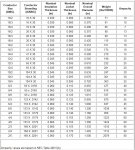For those of you electricians out there. When i have a Nema L14-30 connector rated at 30 amps and a length of 10/4 SO cable that also says 30amps on it, does that mean 30 amps total (15 amps per leg) OR 30 amps per leg?
My gut tells me that it's 15A per leg but i just want to check. FWIW the cable is going to a truss box with 2 15A edison circuits, 1 per leg of the 220, with common neutral and ground.
Thanks!
My gut tells me that it's 15A per leg but i just want to check. FWIW the cable is going to a truss box with 2 15A edison circuits, 1 per leg of the 220, with common neutral and ground.
Thanks!


